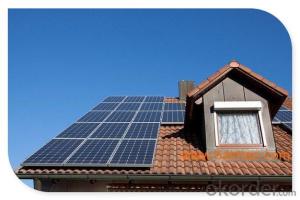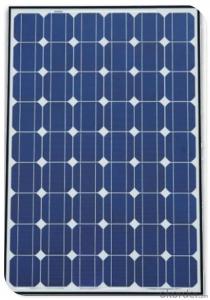275W Direct Factory Sale Price 260-300Watt Solar Panels
- Loading Port:
- China main port
- Payment Terms:
- TT OR LC
- Min Order Qty:
- 10000 watt
- Supply Capability:
- 100000 watt/month
OKorder Service Pledge
OKorder Financial Service
You Might Also Like
Item specifice
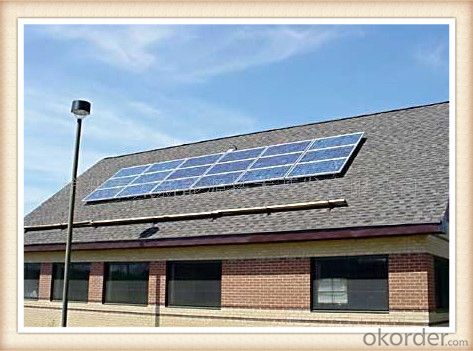
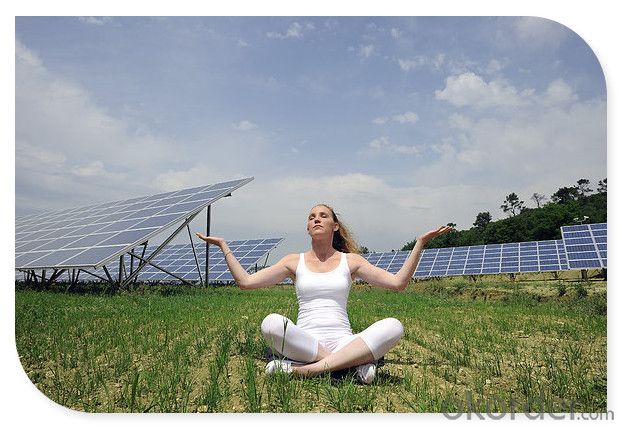
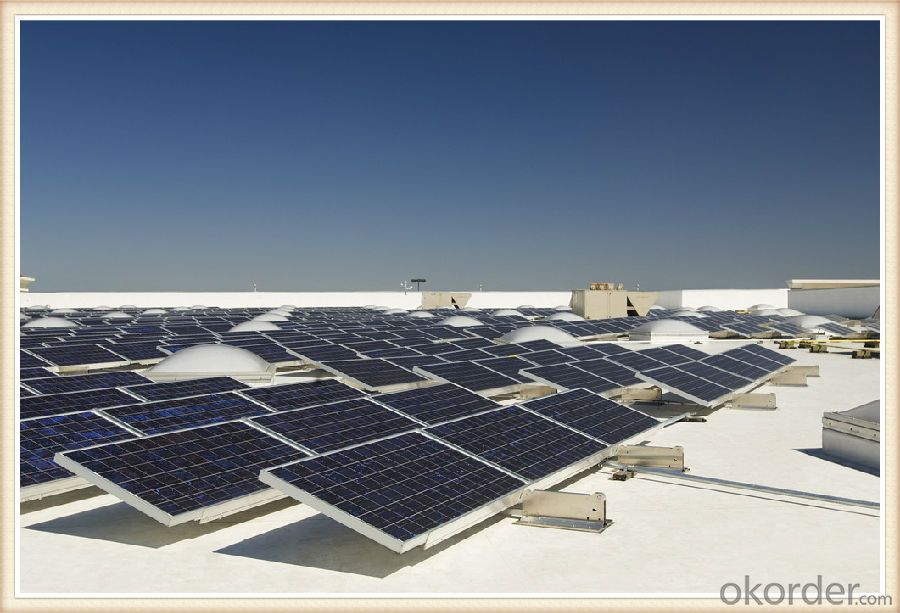
Solar Module Introduction
Solar modules use light energy (photons) from the sun to generate electricity through the photovoltaic effect. The majority of modules use wafer-based crystalline silicon cells or thin-film cells based on cadmium telluride or silicon. The structural (load carrying) member of a module can either be the top layer or the back layer. Cells must also be protected from mechanical damage and moisture. Most solar modules are rigid, but semi-flexible ones are available, based on thin-film cells. These early solar modules were first used in space in 1958.
Electrical connections are made in series to achieve a desired output voltage and/or in parallel to provide a desired current capability. The conducting wires that take the current off the modules may contain silver, copper or other non-magnetic conductive transition metals. The cells must be connected electrically to one another and to the rest of the system. Externally, popular terrestrial usage photovoltaic modules use MC3 (older) or MC4 connectors to facilitate easy weatherproof connections to the rest of the system.
Specification
Model Type | |
Peak Power-Pmax(W) | 5-200W |
Open Circuit Voltage-Voc(V) | 44.2 |
Maximum Power Voltage-Vmp(V) | 36 |
Short Circuit Current-Isc(A) | 5.4 |
Maximum Power Current-Imp(A) | 5 |
Maximum System Voltage | 1000V DC |
Maximum Series Fuse Rating | 10A |
Power Tolerance | -1~+3% |
Temperature Coefficients of Pmax | -0.45%/℃ |
Temperature Coefficients of Voc | -0.348%/℃ |
Temperature Coefficients of Isc | 0.031%/℃ |
Nominal Operating Cell Temperature | 44.5±2℃ |
Standard Testing Condition(STC) | Irradiance:1000W/m²;Temperature:25℃;AM=1.5 |
Qualification Test Parameters | |
Operating Temperature | -40℃~+85℃ |
Storage Temperature | -40℃~+85℃ |
Pressure Bearing | ≥5400Pascal/m² |
Wind Bearing | ≥5400Pascal/m² |
Mechanical Characteristics | |
Cell Size | Mono 125*125mm±0.5 |
No.of Cells | 72pcs(6*12) |
Dimension | 1580*808*40mm |
Weight | 15.5Kg |
Glass | 3.2mm High Transmission,Low Iron |
Frame | Anodized Aluminum Alloy |
Junction Box | IP65Rated |
Internal Diodes | 3 Bypass Diodes |
Cable | 1*4.0mm² Length 900mm |
Images
Packing & Shipping:
We have rich experience on how to pack the panels to make sure the safety on shipment when it arrives at the destination.
The normal size is packed by 25pcs/ carton / pallet. Paper carton for FCL shipping and wood carton for LCL shipping.
Features
1.High reliability with guaranteed -3% to +5% power output tolerance, ensuring return on investment
2.High conversion efficiency based on leading innovative photovoltaic technologies
3.Withstands high wind-pressure and snow load, and extreme temperature variations
4.Attractive appearanceUnique frame design, high mechanical strength, and easy Installation
Warranty:
For c-Si panel: 25years output warranty for no less than 80% of performance, 10 years output warranty for no less than 90% of performance. Free from material and workmanship defects within 5 years.
For a-Si panel: 20 years output warranty for no less than 80% of performance, 10 years output warranty for no less than 90% of performance. Free from material and workmanship defects within 2 years.
•100% product quality protection
•100% on-time shipment protection
•100% payment protection for your covered amount
FAQ:
(1)What price for each watt?
It depends on the quantity, delivery date and payment terms.
(2)What is your size for each module? Can you tell me the Parameter of your module?
We have different series of panels in different output, both c-Si and a-Si. Please take the specification sheet for your reference.
(3)Can you provide the peripheral products of the solar panels, such as the battery, controller, and inverter? If so, can you tell me how do they match each other?
Actually we are only manufacturer of solar panels, but we could try to source them for you in China if you need. We could provide you an optimal system design to instruct you how to install.
(4)Do you have the CE, TUV, UL Certification?
We’ve already passed all the tests, and any certificate is available.
(5)Have you ever sold your products to companies in my country?
Of course, we have customers in all general PV markets, but I think we should expand our market share along with the market growth.
(6)When did your company set up? You are a new company, how can I believe your quality?
We entered into Solar PV industry in 2005, now we have several plants in manufacturing of a-Si and c-Si panels, and our capacity is 220MW per year. Till now we have already passed all the tests by authorized laboratories, e.g. TUV, VDE, UL.
(7)Can you help us install the module if we cooperate with you?
We haven’t entered into installation sector, but we have the plan in near future.
(8) How do you pack your products?
We have rich experience on how to pack the panels to make sure the safety on shipment when it arrives at the destination.
(9) Can you do OEM for us?
Yes, we can.
(10)Can we visit your factory?
Surely, I will arrange the trip basing on your business schedule.
- Q:I am interested in solar energy, but am not sure how eficiant it would be in the northwest? Any comments would be apriciated.
- This okorder
- Q:Can solar panels be used to power a hospital?
- Yes, solar panels can be used to power a hospital. Solar panels convert sunlight into electricity, which can be used to meet the energy needs of various facilities, including hospitals. By installing a solar power system, a hospital can generate clean and renewable energy, reducing its reliance on traditional grid power and potentially saving costs in the long run. However, the feasibility of using solar panels to power a hospital depends on factors such as the hospital's energy requirements, available space for solar panel installation, and the local climate conditions. Additionally, backup power solutions may be necessary to ensure uninterrupted electricity supply during periods of low sunlight or system maintenance.
- Q:Can solar panels be used in cold climates?
- Yes, solar panels can be used in cold climates. In fact, cold temperatures can actually improve the efficiency of solar panels by allowing electrons to flow more easily. However, it is important to ensure that the panels are properly installed and maintained to withstand extreme weather conditions and snow accumulation.
- Q:Is there any way to charge my laptop with a solar panel? Is there any panel like that. Or if I work on panels can I do something like that. If you know anything about it, can you just help me? Thanks a lot.
- A solar panel is usually 36 cells and intended to charge a 2V lead acid battery. The battery in laptops may be somewhere between 5 and 20V. The panel might charge a laptop when it is cold, but they heat up in the sun and then it would no longer charge. Typical lap top power supplies are 3 to 4 amps. You need 2 panels in series to get enough voltage to charge the battery directly, but this is wasteful. If you want to charge at the same rate as a lap top power supply you need large panels to provide 5 amps. The 5 Amp panel will only give 5A when pointed directly at the full sun. There may be between 2 and 5 hours a day equivalent full sun depending where you are, time of year. If you want more than that, you need larger panels, or more than one in parallel for a 2V system. It makes sense to charge a 2V battery with the solar panel, and use that to operate the lap top with a car type power supply for a laptop, which runs from a 2V battery (see link below for an example). Get the biggest panel you can afford, and the battery should be larger if you want to run the lap top when the sun isn't shining. Perhaps a 20AH battery is a minimum size. All this costs more than a lap top.
- Q:How about using Solar Panals to provide the electrical power to separate the H2 from the O? H2 would be fed into the engines carburator like a gas/air mixture ratio, but H2/air mixture ratio instead. How would you control the exact measurements?
- It's a great idea, but there are problems. The first is that hydrogen is very difficult to control; it is a small molecule, and very slippery. It is difficult to handle from that perspective; Teflon tape and other common plumbing techniques just don't cut it. Secondly, once you have the hydrogen, you'd have to compress it in order to put it into a cylinder of some sort. This takes electrical power, and in turn is wasteful. Compressed hydrogen storage has is own risks, including hydrogen embrittlement, and the peculiar nature of hydrogen (including having an invisible flame, and a remarkably wide flammable range) makes it quite dangerous. After all, relatively safe products such as propane gas and butane lighters- well-established and very common- are surprisingly dangerous, causing injuries and fatalities each year. In order for something that is more dangerous (hydrogen) to come to market as being a hydrolysis product, either the products will have to be home-made (and therefore more dangerous), or very expensive.
- Q:Can solar panels be installed on a commercial building?
- Yes, solar panels can be installed on a commercial building. In fact, many businesses and organizations are increasingly adopting solar energy to reduce their carbon footprint and save on energy costs. Installing solar panels on commercial buildings can help generate clean, renewable energy and contribute to a more sustainable future.
- Q:What are the maintenance requirements for solar panels?
- The maintenance requirements for solar panels typically include regular cleaning to remove dirt and debris, checking for any damage or wear, ensuring proper electrical connections, and monitoring the performance of the panels. Additionally, it may be necessary to trim nearby trees or vegetation that could block sunlight and reduce the efficiency of the panels. Overall, proper maintenance helps to maximize the lifespan and efficiency of solar panels.
- Q:Can solar panels be installed on a university campus or educational facility?
- Yes, solar panels can certainly be installed on a university campus or educational facility. In fact, many educational institutions have already embraced solar energy as a sustainable and cost-effective solution. Installing solar panels can help universities reduce their carbon footprint, save money on energy costs, and serve as an educational tool for students to learn about renewable energy.
- Q:Can solar panels be used in areas with high levels of shade?
- Solar panels can still be used in areas with high levels of shade, but their efficiency and energy production may be significantly reduced.
- Q:i wanted to buy solar panels but this guy told me one will just power one light bulb what i want to know is how much thay cost and is it true tat if more power leaves your house than goes in the power company has to send u a cheek
- If you want to get money from the power company you will have to basically put in $0k to $20k worth of solar panels. Currently most solar panels that are available to home owners are not all that efficient. I currently have 3 that are 2 foot x 0 foot on my roof that follow the sun and they only power my water heater. Also some states will give you a tax rebate for installing solar power banks on your roof, mainly in the southwest.
1. Manufacturer Overview |
|
|---|---|
| Location | |
| Year Established | |
| Annual Output Value | |
| Main Markets | |
| Company Certifications | |
2. Manufacturer Certificates |
|
|---|---|
| a) Certification Name | |
| Range | |
| Reference | |
| Validity Period | |
3. Manufacturer Capability |
|
|---|---|
| a)Trade Capacity | |
| Nearest Port | |
| Export Percentage | |
| No.of Employees in Trade Department | |
| Language Spoken: | |
| b)Factory Information | |
| Factory Size: | |
| No. of Production Lines | |
| Contract Manufacturing | |
| Product Price Range | |
Send your message to us
275W Direct Factory Sale Price 260-300Watt Solar Panels
- Loading Port:
- China main port
- Payment Terms:
- TT OR LC
- Min Order Qty:
- 10000 watt
- Supply Capability:
- 100000 watt/month
OKorder Service Pledge
OKorder Financial Service
Similar products
New products
Hot products
Hot Searches
Related keywords
